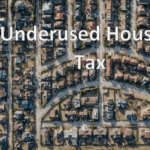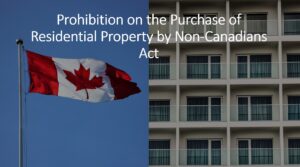MBB LAW INSIGHTS SERIES - REAL ESTATE
Prohibition on the Purchase of Residential Property by Non-Canadians Act
By: Jimmy Lu
Date: January 3, 2022
The Prohibition on the Purchase of Residential Property by Non-Canadians Act[1] (the “Act”) enacted January 1, 2023, bans all non-Canadians from purchasing residential real estate in Canada for a span of two years. When the Act was assented to back in June 2022, there were a lot of gaps left to be filled in. Thankfully, the Canadian federal government released the Prohibition on the Purchase of Residential Property by Non-Canadians Regulations[2] (the “Regulations”) on December 21, 2022, to help us apprehend the Act. Leaving aside the constitutional question as to why the federal government can impose such a restriction, this article will explain who and what types of properties will be affected by the Act.
Who is a non-Canadian?
Section 2 of the Act defines a non-Canadian as[3]:
- an individual who is neither a Canadian citizen nor a person registered as an Indian under the Indian Act nor a permanent resident;
- a corporation that is incorporated otherwise than under the laws of Canada or a province;
- a corporation incorporated under the laws of Canada or a province whose shares are not listed on a stock exchange in Canada for which a designation under section 262 of the Income Tax Act is in effect and that is controlled by a person referred to in paragraph (a) or (b); and
- a prescribed person or entity
According to the Regulations, control occurs if 3% or more of its equity or voting rights is directly or indirectly held by a foreigner; or control in fact, will be deemed as a Non-Canadian[4]. A prescribed person is defined as[5]:
- an entity formed otherwise than under the laws of Canada or a province; and
- an entity formed under the laws of Canada or a province and controlled by an entity referred to in paragraph (a) or controlled by a person referred to in paragraph (a), (b) or (c) of the definition non-Canadian in section 2 of the Act.
What is Residential Property?
Residential properties are defined as[6]:
- a detached house or similar building, containing not more than three dwelling units;
- a part of a building that is a semi-detached house, rowhouse unit, residential condominium unit or other similar premises that is a separate parcel owned apart from another unit in the building; or
- any prescribed real property or immovable.
The Regulations exclude properties that are not within a census agglomeration or a census metropolitan area. A census agglomeration is one that has at least a population of 10,000, and a census metropolitan area is one that has a total population of 100,000 and 50,000 or more must live in the core.[7] Furthermore, vacant land zoned for residential or mixed-uses in a census agglomeration or a census metropolitan area would constitute residential property for the purposes of the Act.[8]
Are There Any Exemptions?
The following are exemptions are available[9]:
- refugees;
- individuals who purchase residential property with their spouse or common-law partner if the spouse or common-law partner is eligible to purchase residential property in Canada;
- a person of a prescribed class of persons.
The Regulations define a person of a prescribed class of persons to whom the Act does not apply as[10]:
- foreign nationals who hold a passport that contains a valid diplomatic, consular, official or special representative acceptance issued by the Chief of Protocol for the Department of Foreign Affairs, Trade and Development;
- foreign nationals, with valid temporary resident status, whose temporary resident visa was issued, or temporary resident status was granted, following an exemption provided under section 25.2 of the Immigration and Refugee Protection Act, if the Minister is of the opinion that the exemption was justified based on public policy considerations to provide safe haven to those fleeing conflict; and
- persons that have made a claim for refugee protection in accordance with subsection 99(3) of the Immigration and Refugee Protection Act, if that claim has been found eligible and referred to the Refugee Protection Division under subsection 100(1) of that Act.
Penalties and Implications
Anyone who “knowingly…counsels, induces, aids or abets” in a contravention of the Act by a non-Canadian, or attempts to do so, is guilty of an offence and liable on summary conviction to a fine of up to $10,000.[11] Furthermore, if a non-Canadian is convicted of having contravened the Act, the Minister may apply to the court for an order to sell the property[12]. The convicted non-Canadian cannot receive, from the proceeds of sale, more than the purchase price paid for the residential property[13], and the proceeds of the sale will be distributed in the following order[14]:
- the payment of the costs of the sale, including the costs incurred by the Minister in bringing the application for the order and any unpaid fines by the non-Canadian under the Act;
- the payment of those, other than the non-Canadian, who are entitled to receive the proceeds of the sale in amounts and according to priorities that the superior court may determine;
- the repayment of the non-Canadian of an amount that is not greater than the purchase price they paid for the residential property; and
- the payment of any amount remaining to the Receiver General for Canada.
Professionals involved in residential real estate may wish to commence a stricter due diligence practice in relation to non-Canadians. Corporations should take note that the extremely low threshold of “control” will include a broader group of entities, and such entities should examine its corporate structure to determine whether it falls under this definition. If you have any questions about how this Act may impact you or your business, please contact us.
________________________
[1] Prohibition on the Purchase of Residential Real Property by Non-Canadians Act, SC2022, C 10.
[2] Prohibition on the Purchase of Residential Property by Non-Canadians Regulations, SOR/2022-250.
[3] Supra note 1, s2.
[4] Supra note 2, s1.
[5] Ibid, s.2.
[6] Supra note 1, s1.
[7] Supra note 2, s3(1).
[8] Ibid note 2, s3(2).
[9] Supra note 1, s4(2).
[10] Supra note 2, s6.
[11] Supra note 1, s6(1).
[12] Ibid note 1, s7(1).
[13] Ibid, s8(2).
[14] Supra note 2, s7(2).
More Articles:
 Underused Housing TaxIn Insights, Real Estate
Underused Housing TaxIn Insights, Real Estate Toronto Vacant Home TaxIn Insights, Real Estate
Toronto Vacant Home TaxIn Insights, Real Estate

